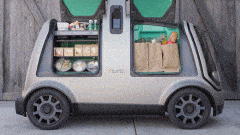But these are not autonomous versions of normal cars, but cars designed for this purpose, and they are much smaller

Just this month, just before 2018 comes to a close, driverless vehicles began making deliveries on Arizona roads. To clarify: these are not vehicles with a normal shape. Until now, conventional driverless vehicles have only come into use with a human babysitter sitting behind the wheel, ready to hit the brakes as soon as the vehicle makes a mistake. But in the new autonomous delivery vehicles, there is no place for the human driver at all. In fact, they are so small that a human cannot even enter them. They look like a combination of a large, white box on wheels, with a pair of lift-up doors that open To allow customers access to the groceries that the vehicle brought to them[1].
The new vehicle is smaller than a normal car, and much lighter. It rolls on the roads at a speed of 40 km/h, and is therefore much less dangerous for pedestrians and other vehicles in the event of an accident. And even if an accident happens, we have already mentioned that it is lighter and should cause less damage in a collision. And since it has no human passengers, you don't have to worry about them at all.
This story yields two interesting key lessons.
The first lesson is that companies that want to succeed in the new market must carefully consider which of the existing concepts they want to continue to stick to. We see that the company behind the new autonomous vehicle - Nuro) - takes a very different strategy from that of the larger autonomous vehicle companies, such as Waymo and Tesla. Waymo, for example, is trying to take vehicles in their current form and turn them into autonomous taxis. The result is that Waymo's vehicles are heavy, bulky, and wasteful of energy since they only carry one or two passengers at a time, even though the original vehicle is designed to carry at least four passengers plus a driver. The legislator is (rightly) afraid of what will happen to the passengers in these vehicles in the event of an accident, and therefore demands that Waymo and its ilk meet extremely high safety standards. Until the fully autonomous vehicles can meet these standards, at least one more year will pass (and probably more). And so, Waymo's adherence to the primitive form of the vehicle is delaying the penetration of its vehicles into the market.
Noro operates more intelligently, adapting its robots only to the limited task they are supposed to fulfill. Noro's autonomous vehicles, as mentioned, are smaller, lighter and safer. They can only carry shipments, but that's exactly what they're meant for, and that's perfectly fine. When Noro decides to expand to transporting pizzas, for example, or medicines, it will be able to engineer its robots according to the new needs. But by then, its robots will have gained plenty of experience on the road.
And here comes the second important lesson: in the field of artificial intelligence, There is a big advantage for the first[2]. Why? Because modern artificial intelligence is largely based on artificial neural networks, and these are based on information they receive. The more information they are fed, the more accurate and successful decisions they can make. This means that the company that will be the first to bring its autonomous vehicles to the roads will have a big advantage over the others, because these autonomous vehicles will collect a wealth of information that will be used to train the artificial intelligence and improve their performance.
This, by the way, is the reason why Tesla opened up the possibility for the public to use its 'automated driver' option, even though it is still very far from perfect. It wants to collect information that will help improve it, so that it can compete with other companies that will develop their own autonomous vehicles. And this is also why Nuru is trying to release its autonomous robots onto the roads, despite their very limited capabilities: they are supposed to collect information, thus helping to train the next generation of autonomous robots that will move on the roads.
So one can only wish Noro success in the new development. The more autonomous vehicles there are on the road, the faster they will learn and advance us all to the future of robots on the roads, which will arrive even sooner than we all anticipated (well, well, except for me, because I'm a futurist).
More of the topic in Hayadan:

2 תגובות
Nice idea. The direction looks promising
These vehicles must travel on sidewalks or bike lanes only. On the road, a small vehicle traveling 40 km/h will cause an accident within minutes, because the drivers who travel much faster will not see it and run over it, and if they see it, they will try to swerve and collide with another vehicle.